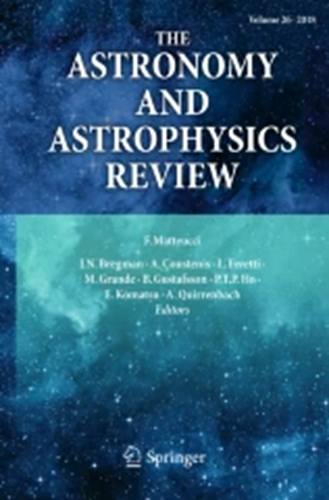大尺度偏差修正后亚毫米星系放大偏差的宇宙学约束
IF 26.5
1区 物理与天体物理
Q1 ASTRONOMY & ASTROPHYSICS
引用次数: 2
摘要
上下文。通过相互关联函数的分析,研究前景星系对高红移亚毫米星系产生的放大偏倚,最近被证明是一个有趣的独立替代弱透镜剪切作为宇宙学探测器。在提出的可观测对象的情况下,大多数宇宙学约束主要取决于最大角度分离测量。因此,我们的目标是研究和纠正影响前景和背景星系样本的主要大尺度偏差,以产生一个鲁棒的互相关函数估计。然后对修正后的信号进行分析,推导出更新的宇宙学约束。我们使用H-ATLAS星系的背景样本(光度红移> 1.2)和两个不同的前景样本(GAMA星系的光谱红移或SDSS星系的光度红移,均在0.2 < z < 0.8范围内)测量了大尺度、偏差校正的互相关函数。这些测量是使用传统的光环模型描述来建模的,该模型依赖于光环的占据分布和宇宙学参数。然后,我们通过在多个场景下执行马尔可夫链蒙特卡罗来估计这些参数,以研究该可观测值的性能以及如何改进其结果。经过大规模偏差校正后,我们只获得了相对于先前放大偏差结果的微小改进,主要证实了他们的结论:在95% CL下Ωm的下界> 0.22,在95% CL下σ8的上界< 0.97(来自zspec样本的结果)。前景光度样品的高表面密度和剩余无约束参数的高斯先验假设都没有显著改善导出的约束。然而,通过将两个前景样本结合到简化的层体层分析中,我们能够在Ωm−σ8平面上获得如下有趣的约束:Ωm = 0.50−0.20+0.14,σ8 = 0.75−0.10+0.07,68% CL。本文章由计算机程序翻译,如有差异,请以英文原文为准。
Cosmological constraints on the magnification bias on sub-millimetre galaxies after large-scale bias corrections
Context. The study of the magnification bias produced on high-redshift sub-millimetre galaxies by foreground galaxies through the analysis of the cross-correlation function was recently demonstrated as an interesting independent alternative to the weak-lensing shear as a cosmological probe.
Aims. In the case of the proposed observable, most of the cosmological constraints mainly depend on the largest angular separation measurements. Therefore, we aim to study and correct the main large-scale biases that affect foreground and background galaxy samples to produce a robust estimation of the cross-correlation function. Then we analyse the corrected signal to derive updated cosmological constraints.
Methods. We measured the large-scale, bias-corrected cross-correlation functions using a background sample of H-ATLAS galaxies with photometric redshifts > 1.2 and two different foreground samples (GAMA galaxies with spectroscopic redshifts or SDSS galaxies with photometric ones, both in the range 0.2 < z < 0.8). These measurements are modelled using the traditional halo model description that depends on both halo occupation distribution and cosmological parameters. We then estimated these parameters by performing a Markov chain Monte Carlo under multiple scenarios to study the performance of this observable and how to improve its results.
Results. After the large-scale bias corrections, we obtain only minor improvements with respect to the previous magnification bias results, mainly confirming their conclusions: a lower bound on Ωm > 0.22 at 95% CL and an upper bound σ8 < 0.97 at 95% CL (results from the zspec sample). Neither the much higher surface density of the foreground photometric sample nor the assumption of Gaussian priors for the remaining unconstrained parameters significantly improve the derived constraints. However, by combining both foreground samples into a simplified tomographic analysis, we were able to obtain interesting constraints on the Ωm − σ8 plane as follows: Ωm = 0.50−0.20+0.14 and σ8 = 0.75−0.10+0.07 at 68% CL.
求助全文
通过发布文献求助,成功后即可免费获取论文全文。
去求助
来源期刊

The Astronomy and Astrophysics Review
地学天文-天文与天体物理
CiteScore
45.00
自引率
0.80%
发文量
7
期刊介绍:
The Astronomy and Astrophysics Review is a journal that covers all areas of astronomy and astrophysics. It includes subjects related to other fields such as laboratory or particle physics, cosmic ray physics, studies in the solar system, astrobiology, instrumentation, and computational and statistical methods with specific astronomical applications. The frequency of review articles depends on the level of activity in different areas. The journal focuses on publishing review articles that are scientifically rigorous and easily comprehensible. These articles serve as a valuable resource for scientists, students, researchers, and lecturers who want to explore new or unfamiliar fields. The journal is abstracted and indexed in various databases including the Astrophysics Data System (ADS), BFI List, CNKI, CNPIEC, Current Contents/Physical, Chemical and Earth Sciences, Dimensions, EBSCO Academic Search, EI Compendex, Japanese Science and Technology, and more.
 求助内容:
求助内容: 应助结果提醒方式:
应助结果提醒方式:


